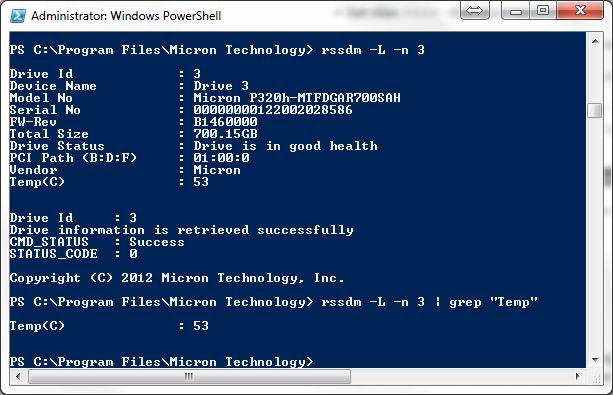MICRON’S REALSSD MANAGER
Micron’s P320h is accompanied by two powerful management options. The command line manager works for both Linux and Windows systems, and is provided for servers without graphical interfaces. Many will actually prefer the CLI way of managing the P320h.
The command line interface may allow users more flexibility, but the GUI is pretty nifty too. The GUI is just a front end for the command line RealSSDManager, but the interface is simple and clean.
The main tab of the RealSSDManager shows media wearout, throughput, and temperature “gauges”. The P320 gets warm just idling, but can get downright toasty when writing for sustained periods of time. The P320h begins throttling when temps hit 87 degrees Celsius, until such time as the internal sensor detects temps returning to a normal operating range.
Both managers also are capable of tracking throughput in MB/s. In the circumstances above, the P320h is shown writing for eighty minutes, with corresponding temperature logs. With multiple drives deployed, keeping an eye on all of them simultaneously isn’t easy without tools like these.
Lastly, Micron has seen fit to equip the P320h with useful, if not totally comprehensive SMART data. This unit suffered an erase failure during testing, and is 1% of the way to write protect mode. Once the drive decides the flash is completely worn, it protects the data left by going into a read-only operation. Micron’s other drives do this as well, as do many other makes and models. It is nearly impossible to actually see this happen in the real world, though.
The P320h does have a somewhat unique feature. Three different interrupt coalescing settings are provided, depending on whether the Micron is going to be used in environments with significantly less or more than 256 outstanding commands. Essentially, these interrupt settings define when commands get posted. The default D200F setting is the best all around setting, but in cases where OIO count is greater than 256, the D801F setting can let more IOs get posted with a single interrupt. For lower QD operation, the D020F setting can help optimize performance with less than 32 commands outstanding. Still, the P320h is clearly intended for demanding applications, and using it at low QD is not optimal.
 The SSD Review The Worlds Dedicated SSD Education and Review Resource |
The SSD Review The Worlds Dedicated SSD Education and Review Resource | 


Micron doesnt own the controller. It is made by IDT.
We are aware of that, thanks. Our reasoning behind wording as such is because this is, by no means, a simple stock implementation of a controller and similar could not have been accomplished without Micron’s engineering expertise and software. Great point and perhaps we could reword things just a bit…
Micron has a Minneapolis-based controller team which did much of the work on the controller. Basically, IDT has a stock PCIe controller, but it’s easily modified for custom jobs. Micron refined the design for the P320h. IDT now has a reference NVMe design, but the NVMe standard is far from universal yet. One day, a PCIe SSD won’t need a special driver, but today they do.
Micron developed and owns the chip, IDT just fabs it.
Incorrect. This is the very same controller that is used with the new NVMe controllers that IDT has developed.
Just to help you out, this is what has been posted at Anands after they inadvertently stated it was NVMe.:
Update: Micron tells us that the P320h doesn’t
support NVMe, we are digging to understand how Micron’s controller
differs from the NVMe IDT controller with a similar part number.
Our interpretation of the chip appears to be correct as it is written and this same ‘structure’ has been used in the SSD industry prior. This is not a simple plug and play adaption of a chip, but rather, custom package.
Thanks again.
Yes, it isnt NVMe, but it is an IDT chip, therefore it is not developed in house by Micron.
old news
Just needs a few heat sinks and a fan or maybe a water block to keep it cooler.
Todd – What makes you think you know so much about this chip?
Is the RAIN implementation safe enough to use without RAID 1 running outside of it (say across 2 350GB cards) it sounds good, but if you have a firmware or controller related failure you’re still at risk right?
Is this bootable? And just for kicks, what would the as-ssd results be?